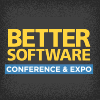Better Software Conference & EXPO 2007

PRESENTATIONS
|
Lean Thinking: How Lean Bakes Quality In
The Lean movement, instituted in the 1950s with Toyota's redefinition of automobile production, has knocked the manufacturing world on its ear. At the core of the Lean movement is the notion of eliminating waste as the key to creating added value. What is not well understood is the role that quality plays in defining many of the core Lean Thinking practices. Practices such as Stop the Line, Zero Defects, and Reduced Inventory all focus teams on quality. |
|
|
Measuring and Monitoring the End Game of a Software Project: Part Deux
How do you know when a product is ready to ship? QA managers have faced this question for years. Mike Ennis shares a process he uses to take the guessing out of when to ship a product, replacing guessing with key metrics to help you rationally make the right ship decision. Learn how to estimate, predict, and manage your software project as it gets closer to its release date. Mike shows you which metrics to track and how to collect them without undue overhead on the project. |

Mike Ennis, Accenture |
|
Patterns for Improved Customer Interaction
With the emphasis on in-depth customer interaction during development, team members are being asked to take an active role in working with customers. This evolving role poses a big challenge for many who, in the past, rarely met "real" customers. Linda Rising presents patterns she has used successfully to help software professionals in their direct, face-to-face interactions with customers. These patterns describe solutions to common problems that occur again and again dealing with customers and users. |

Linda Rising, Independent Consultant |
|
Points of Defect Creation: Speeding Detection and Correction
Software development methodologies try to improve quality by promoting the tactic of testing "early and often." When a defect is detected, a report is filed, the developer tries to reproduce and repair the problem, and then testing must verify that the modification corrected the problem and did not create any new problems. Because it doesn't prevent the same types of errors from recurring, this approach is time consuming, costly, and inefficient. |
|
|
Practical Software Sizing with Testable Requirements
A new strategic project is in the design stages-how much will it cost? Your application requirements are constantly growing-what is the impact? System testing is scheduled soon-how much time and what resources will we need? And how do you get the answers? Measurement. Although software developers are often collecting measures of defects, earned value, variances, etc., the most fundamental measure-how big is the system?-is usually lacking. |
|
|
Quantitative and Statistical Management Applications
There is no longer any question that-when appropriately used-quantitative measurement and management of software projects works. As with any tool, the phrase "appropriately used" tells the tale. |
|
|
Real World SOA: From Concept to Application
Service Oriented Architecture (SOA) is becoming a widely adopted approach for enterprises to attain agility and economy while meeting their Information Technology (IT) needs. Unlike previous attempts at component based software development efforts, development in SOA environments stresses code reuse through development, deployment, and orchestration standards. |
|
|
Retrospectives: A Superior Alternative to Traditional Postmortems
Organizations have traditionally relied on project postmortems to assess the performance of product development teams. The irony is that "postmortem" literally means "after death," implying a discussion of project failures. These reviews, held at the end-either the completion or cancellation-of a project, often do not create a safe environment for team members to express their opinions. |

John Terzakis, Intel |
|
Risk Management--It's Not Just For Gamblers Any More
The difference between gamblers and many software managers is that gamblers know there is a good chance they will lose a bet. An intelligent blackjack player can expect to win 45-49 percent of the time; software project success rates have only recently passed the 33 percent mark. Payson Hall argues that a key to project success is improving our ability to identify and manage risks-technology risks, project risks, business risks, and more. |

Payson Hall, Catalysis Group, Inc. |
|
SOA Governance: The Process Change Required for Succcess
The SOA revolution is already underway in many IT organizations. SOA creates new cultural, organizational, and technological challenges that must be met to ensure success. Merely implementing web services and enterprise service buses will not address the key issues in building organizational support and standardized adoption throughout the organization. Without the proper organizational process infrastructure, you will be left with SOA program chaos and SOA infrastructure shelf ware. |
|


